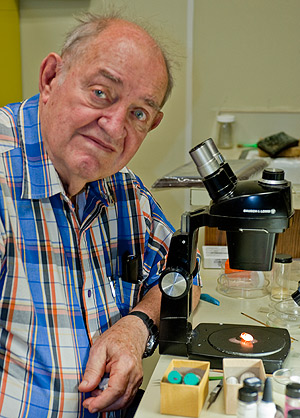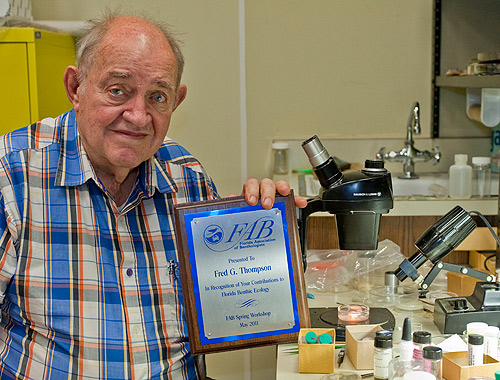
Photo by Jeff Gage
Following more than 40 years of fieldwork, Florida Museum of Natural History malacology curator Fred Thompson was recently recognized for his research on freshwater organisms.
The Florida Association of Benthologists presented Thompson with the Award for Excellence in Contributions to Florida Benthic Ecology in recognition of accomplishments throughout his career. The award can be presented no more than once a year and was last awarded in 2008, said Gary Warren, an executive committee member and one of the association’s founders.
“It’s been awhile since we thought we had somebody worthy of the award,” said Warren, an aquatic invertebrate ecologist with the Florida Fish and Wildlife Conservation Commission. “Every one [of the members] has been dependent on Dr. Thompson’s identification manuals – he is a resource for people that have specimens they can’t identify and he’s always been available.”
The association is comprised of about 250 scientists throughout Florida whose careers involve benthology, the study of all aquatic organisms on the bottom of water bodies, from protozoa, clams and snails to worms and crayfish. The association presented Thompson with the award during its annual taxonomic workshop in May.
Though small, these creatures serve an important role in helping balance the ecology of water systems throughout the world. Snails are among the most expansive of aquatic animals and comprise the largest group of primary consumers (herbivores) in aquatic ecosystems, feeding on decaying plant materials, algae, aquatic fungi and yeast. It was these organisms that piqued Thompson’s interest as a high school student in the 1950s.
“I was going around to various places in Ohio on field trips, encountering snails and finding there was very little published information on them,” Thompson said. “It expanded my curiosity about who is who in the animal world.”
Thompson’s primary research focuses on the evolutionary relationships of freshwater and land snails, which make up the most diverse group of animals next to insects, he said. He has published more than 100 journal articles, from naming new species in North and Central America to creating the only identification guide for the state’s freshwater snails. “The Freshwater Snails of Florida: A Manual for Identification” was published in 1984 and most recently updated in 2004.
“A lot of what we know about small snails in springs in Florida is the result of Fred’s work,” said John Slapcinsky, Florida Museum malacology collections manager. “He has basically revolutionized our understanding of these organisms.”
Thompson helped identify species from the underexplored snail family Hydrobiidae. These habitat-specific snails are endangered because destruction of a spring or river shoal leads to their demise, Slapcinsky said.

Photo by Jeff Gage
“Many spring snails are minute and very hard to work on, so most people have stayed away from them as much as they can,” Slapcinsky said. “But Fred has waded into the group and discovered numerous species in Florida and the southeast. Without Fred’s work, we would not even know that many of these vulnerable snails existed.”
There are about 500 species of freshwater snails in North America, many of which are confined to single springs or small bodies of water and highly threatened by environmental change. Like canaries in coal mines, these snails serve as environmental indicators, in this case the springs and aquifer, the source of the state’s drinking water.
“Biodiversity is a very important concern and the devolution of any aspect of biodiversity in an area is a serious loss ecologically – the loss of any particular species could constitute a food resource loss for other animals,” Thompson said. “Likewise, Florida aquatic systems are a favorite playground for people to introduce exotics and these places could serve as hosts for human-significant parasites transmitted by snails.”
The presentation of the lifetime achievement award and the event, held in Gainesville, left Thompson “rather dumbfounded and very humbled” he said. As more private springs are opened to the public, it should be no surprise to see the 76-year-old in a canoe with his two dogs, using a sieve to scoop evidence of life from the bottom of the state’s water systems.
“A lot of the members of the association both past and present have been dependent on Thompson’s work,” said Warren, who was president of the association in the late 1980s. “Without the work that Dr. Thompson has done, we wouldn’t be able to produce the quality work that we do.”